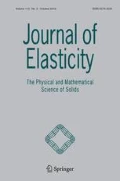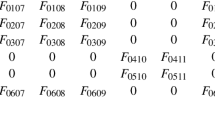Abstract
In this paper, following the Backus (in J. Geophys. Res. 67(11):4427–4440, 1962) approach, we examine expressions for elasticity parameters of a homogeneous generally anisotropic medium that is long-wave-equivalent to a stack of thin generally anisotropic layers. These expressions reduce to the results of Backus (1962) for the case of isotropic and transversely isotropic layers.
In the over half-a-century since the publications of Backus (1962) there have been numerous publications applying and extending that formulation. However, neither George Backus nor the authors of the present paper are aware of further examinations of the mathematical underpinnings of the original formulation; hence this paper.
We prove that—within the long-wave approximation—if the thin layers obey stability conditions, then so does the equivalent medium. We examine—within the Backus-average context—the approximation of the average of a product as the product of averages, which underlies the averaging process.
In the presented examination we use the expression of Hooke’s law as a tensor equation; in other words, we use Kelvin’s—as opposed to Voigt’s—notation. In general, the tensorial notation allows us to conveniently examine effects due to rotations of coordinate systems.
Similar content being viewed by others
References
Anderson, D.L.: Elastic wave propagation in layered anisotropic media. J. Geophys. Res. 66, 2953–2964 (1961)
Backus, G.E.: Long-wave elastic anisotropy produced by horizontal layering. J. Geophys. Res. 67(11), 4427–4440 (1962)
Berryman, J.G.: Range of the \(P\)-wave anisotropy parameter for finely layered VTI media. Stanf. Explor. Proj. 93, 179–192 (1997)
Bond, W.L.: The mathematics of the physical properties of crystals. Bell Syst. Tech. J. 22, 1–72 (1943)
Brisco, C.: Anisotropy vs. inhomogeneity: algorithm formulation, coding and modelling, Honours Thesis, Memorial University (2014)
Carcione, J.M., Picotti, S., Cavallini, F., Santos, J.E.: Numerical test of the Schoenberg-Muir theory. Geophysics 77(2), C27–C35 (2012)
Chapman, C.H.: Fundamentals of Seismic Wave Propagation. Cambridge University Press, Cambridge (2004)
Dalton, D., Slawinski, M.A.: On Backus average for oblique incidence (2016). arXiv:1601.02966v1 [physics.geo-ph]
Danek, T., Kochetov, M., Slawinski, M.A.: Effective elasticity tensors in the context of random errors. J. Elast. 121(1), 55–67 (2015)
Danek, T., Slawinski, M.A.: Backus average under random perturbations of layered media. SIAM J. Appl. Math. 76(4), 1239–1249 (2016)
Gazis, D.C., Tadjbakhsh, I., Toupin, R.A.: The elastic tensor of given symmetry nearest to an anisotropic elastic tensor. Acta Crystallogr. 16(9), 917–922 (1963)
Haskell, N.A.: Dispersion of surface waves on multilayered media. Bull. Seismol. Soc. Am. 43, 17–34 (1953)
Helbig, K.: Elastischen Wellen in anisotropen Medien. Getlands Beitr. Geophys. 67, 256–288 (1958)
Helbig, K.: Layer-induced anisotropy: forward relations between constituent parameters and compound parameters. Rev. Bras. Geofís. 16(2–3), 103–114 (1998)
Helbig, K.: Inversion of compound parameters to constituent parameters. Rev. Bras. Geofís. 18(2), 173–185 (2000)
Helbig, K., Schoenberg, M.: Anomalous polarization of elastic waves in transversely isotropic media. J. Acoust. Soc. Am. 81(5), 1235–1245 (1987)
Kumar, D.: Applying Backus averaging for deriving seismic anisotropy of a long-wavelength equivalent medium from well-log data. J. Geophys. Eng. 10, 1–15 (2013)
Postma, G.W.: Wave propagation in a stratified medium. Geophysics 20, 780–806 (1955)
Riznichenko, Yu.Y.: On seismic anisotropy. Izv. Akad. Nauk SSSR, Ser. Geogr. Geofiz. 13, 518–544 (1949)
Rudzki, M.P.: Parametrische Darstellung der elastischen Wellen in anisotropischen Medie. Bull. Acad. Cracovie 503 (1911)
Rytov, S.M.: The acoustical properties of a finely layered medium. Akust. ž. 2, 71 (1956). See also Sov. Phys. Acoust. 2, 67 (1956)
Schoenberg, M., Muir, F.: A calculus for finely layered anisotropic media. Geophysics 54(5), 581–589 (1989)
Shermergor, T.: Theory of Elasticity of Microinhomogeneous Media. Nauka, Moscow (1977). In Russian
Slawinski, M.A.: Waves and Rays in Seismology: Answers to Unasked Questions. World Scientific, Singapore (2016)
Slawinski, M.A.: Waves and Rays in Elastic Continua. World Scientific, Singapore (2015)
Tiwary, D.K.: Mathematical modelling and ultrasonic measurement of shale anisotropy and a comparison of upscaling methods from sonic to seismic. Ph.D. thesis, University of Oklahoma (2007)
Thomson, W.T.: Transmission of elastic waves through a stratified solid medium. J. Appl. Phys. 21, 80–93 (1950)
White, J.E., Angona, F.A.: Elastic wave velocities in laminated media. J. Acoust. Soc. Am. 27, 310–317 (1955)
Acknowledgements
We wish to acknowledge discussions with George Backus, Klaus Helbig, Mikhail Kochetov and Michael Rochester. Also, we wish to acknowledge insightful comments of an anonymous reviewer and proofreading by Elena Patarini. This research was performed in the context of The Geomechanics Project supported by Husky Energy. Also, this research was partially supported by the Natural Sciences and Engineering Research Council of Canada, grant 238416-2013.
Author information
Authors and Affiliations
Corresponding author
Appendices
Appendix A: Average of Derivatives (Lemma 1)
Proof
We begin with the definition of averaging,
We make the nonrestrictive assumption that \(f(\xi)\) is sufficiently regular to be able to perform the standard calculus operations that we make below. The derivatives with respect to \(x_{1}\) and \(x_{2}\) can be written as
where the last equality is the statement of definition (12), as required. For the derivatives with respect to \(x_{3}\), we need to verify that
Applying integration by parts, we write the right-hand side as
where \(w\) is a function of a single variable. Since
the product of \(w\) and \(f\) vanishes at \(\pm\infty\), and we are left with
Let us consider the left-hand side of expression (13). Since only \(w\) is a function of \(x_{3}\), we can interchange the operations of integration and differentiation to write
the negative sign arises from the chain rule,
Thus, both sides of expression (13) are equal to one another, as required. In other words,
which completes the proof. □
Appendix B: Stability of Equivalent Medium (Lemma 2)
Proof
The stability of layers means that their deformation requires work. Mathematically, it means that, for each layer,
where \(W\) stands for work, and \(\sigma\) and \(\varepsilon\) denote the stress and strain tensors, respectively, which are expressed as columns in (4): \(\sigma=C\varepsilon\). As an aside, we can say that, herein, \(W>0\) is equivalent to the positive definiteness of \(C\), for each layer.
Performing the average of \(W\) over all layers and using—in the scalar product—the fact that the average of a sum is the sum of averages, we write
Thus, \(W>0\implies\overline{W}>0\).
Let us proceed to show that this implication—in turn—entails the stability of the equivalent medium, which is tantamount to the positive definiteness of \(\langle C\rangle\).
Following Lemma 3—if one of two functions is nearly constant—we can approximate the average of their product by the product of their averages,
Herein, we use the property stated in Sect. 2.4 that \(\sigma_{i3}\), where \(i\in\{1,2,3\}\), are constant, and \(\varepsilon_{11}\), \(\varepsilon_{12}\) and \(\varepsilon_{22}\) vary slowly, along the \(x_{3}\)-axis, together with Lemma 3, which can be invoked due to the fact that each product in expression (14) is such that one function is nearly constant and the other possibly varies more rapidly.
By definition of Hooke’s law, \(\overline{\sigma}:=\langle C\rangle \overline{\varepsilon}\), expression (14) can be written as
which means that \(\langle C\rangle\) is positive-definite, and which—in view of this derivation—proves that the equivalent medium inherits the stability of individual layers. □
Appendix C: Approximation of Product (Lemma 3)
For a fixed \(x_{3}\), we may set \(W(\zeta):=w(\zeta-x_{3})\). Then, \(W\geq0\) and \(\int_{-\infty}^{\infty}W(\zeta)\mathrm{d}\zeta =1\). With this notation, (3) becomes
Similarly,
Proposition 1
Suppose that the first derivatives of \(f\) and \(g\) are uniformly bounded; that is, both
are finite. Then, we have
Proof
We may calculate
that is,
Now,
so that
and hence, by the Cauchy-Schwartz inequality,
Thus,
It follows, by the Cauchy-Schwartz inequality applied to (15), that
Note that
using the defining properties of \(w(\zeta)\). Similarly
Consequently,
and we have
as claimed. □
Hence, if \(f\) and \(g\) are nearly constant, which means that \(\|f'\|_{\infty}\) and \(\|g'\|_{\infty}\) are small, then \(\overline{fg}\approx\overline{f} \overline{g}\).
Corollary 1
Since the error estimate involves the product of the norms of the derivatives, it follows that if one of them is small enough and the other is not excessively large, then their product can be small enough for the approximation, \(\overline{fg}\approx\overline{f} \overline{g}\), to hold.
The exact accuracy of this property will be examined further by numerical methods in a future publication.
If \(g(x)\geq0\), we can say more, even if \(g(x)\) is wildly varying. If \(f\) is continuous and \(g(x)\geq0\), then, by the Mean-value Theorem for Integrals,
for some \(c\). Hence,
This implies that
Hence, even for \(g\) wildly varying—as long as \(\overline{g}\) is not too big in relation to \(\|f'\|_{\infty}\)—it is still the case that the average of the product is close to the product of the averages. A bound on \({\int_{-\infty}^{\infty}|x-y|W(y)\mathrm{d}y}\) would depend on the weight function, \(w\), used.
An alternative estimate is provided by the following proposition.
Proposition 2
Suppose that \(m:=\inf f(x)>-\infty\) and \(M:=\sup_{-\infty < x<\infty}f(x)<\infty\) and \({\sup_{-\infty< x<\infty }|g(x)|<\infty}\). Then,
Proof
which—by the definition of the average—is
Hence,
Similarly,
Taking the average of expressions (17) and (18), we obtain
as required. □
Consequently, if \(f(x)\) is almost constant—which means that \(m\approx M\)—then \(\overline{fg}\approx\overline{f}\overline{g}\).
Rights and permissions
About this article
Cite this article
Bos, L., Dalton, D.R., Slawinski, M.A. et al. On Backus Average for Generally Anisotropic Layers. J Elast 127, 179–196 (2017). https://doi.org/10.1007/s10659-016-9608-z
Received:
Published:
Issue Date:
DOI: https://doi.org/10.1007/s10659-016-9608-z




